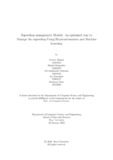Supershop management Models: An optimised way to manage the supershop using hyperautomation and machine learning
Abstract
Customers are the heart and soul of supermarkets, and these stores often suffer
losses due to mishandling of customer service. This study aims to examine how
the satisfaction of customers can be maximized with the help of hyper-automation
technologies in order to operate the stores successfully. Here, an intelligent voice bot
is used to reduce response time for basic customer queries by providing real-time
replies using NLP and for further complex queries, customers will be provided with
contact info or forwarded to relevant authorities. In addition to that we predicted
customer demands for future products by using multiple machine learning libraries
like XGBoost, Linear Regression and Random forest with the help of daily sales
data. This helps supermarkets to stock a perfect amount of products in their in ventory which will help them to avoid any kind of product shortage in any season
and will help them to achieve customer satisfaction. Furthermore, optimized prod uct placement will be ensured with the use of data mining techniques like Apriori
algorithm ,FP Growth algorithm and GSP algorithm. By doing this we are making
it easy for the customers to find out their preferred product together in a single
shelf and reducing customer hassle of iterating through the whole shop to find the
products from their shopping list. As well as, to ensure a hassle-free transaction
between consumer and seller, a system is proposed using Smart Contract System
via Block chain which can make the process faster, and ensure transaction safety
at the same time.For results, With an R-Squared score of 0.963, we discovered that
the hybridization of linear-boost regression was the most suited for forecasting. The
best outcomes for product placement were provided by FP Growth. For the pur poses of the chatbot, let’s say that for the two strings ”rfl nipple 3-6 month” and ”rfl
nipple 3 to 6 month,” the spaCy llibrary and nltk’s bleu function both yield 90.8 and
66.21 percent similarity, respectively. Now, based on the %, you could assume that
the spaCy library is operating more effectively, but this is untrue. SpaCy library
functions. better in a big model where pre-trained word vectors are present, but not
in a small model. However, the smart contract system successfully carried out all
of the system’s algorithms and guaranteed transaction security as well as product
safety.
By using the Hyper Automation technology Super stores can ensure better customer
service. The budget and implementation of such technologies combined into a system
turned out to be both high and complicated. However, as time passes, the cost of
these technologies will decrease rapidly and their usage will be further simplified.

